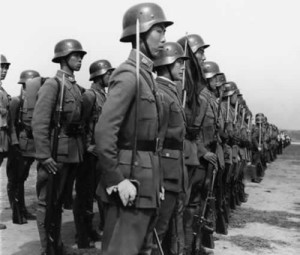Battle of Shanghai: A German Cameraman’s View
- By Peter Harmsen
- 6 June, 2014
- 2 Comments
 The German newsreel below shows highlights of the 1937 battle of Shanghai. It’s interesting for a number of reasons. First, it features several of the weapons that were used most aggressively by the two sides of the struggle, including a Japanese 75 mm mountain gun (at 0:24), Chinese Curtiss Hawk biplanes (0:27), and a Japanese M25 Vickers Crossley four-wheeled armored car (0:55).
The German newsreel below shows highlights of the 1937 battle of Shanghai. It’s interesting for a number of reasons. First, it features several of the weapons that were used most aggressively by the two sides of the struggle, including a Japanese 75 mm mountain gun (at 0:24), Chinese Curtiss Hawk biplanes (0:27), and a Japanese M25 Vickers Crossley four-wheeled armored car (0:55).
Even more interestingly, there is no obvious bias in the reporting of the events. The commentary restricts itself to merely describing what’s going on in the footage. At the same time, there is a surprising focus on the plight of Shanghai’s civilian population, and a large part of the two-minute newsreel shows streams of refugees weighed down by their belongings trying desperately to gain entry into the international part of the city, which was recognized by both the Chinese and the Japanese as a no-go zone.
It appears that the German media were free to report about the battle in Shanghai without being ordered to favor either side in a too obvious manner. This reflected the fact that Berlin’s diplomacy was in a state of flux. By 1937, there was growing understanding between Nazi Germany and the Japanese empire. They were united in their hostility towards the Soviet Union, reflected in the Anti-Comintern Pact, directed against Moscow, which the two had signed towards the end of the previous year. But they would not enter into a formal alliance – the Axis – until three years later.
In Shanghai in 1937, some German reporters put their freedom to report the events as they saw them – relative as this freedom was – to good use. Probably the best example was Lily Abegg, then 35 years old. She was actually Swiss, had spent part of her childhood in Japan, and reported from Shanghai for the German newspaper Frankfurter Zeitung.
As late as March 1940, when she published Chinas Erneuerung, a book about the conflict in the Far East, Abegg was able to write the following about the supreme Chinese leader Chiang Kai-shek: “No one believes that such a man has lived in vain – not even in Japan, where this great adversary has always been respected, in spite of all the hostility.”



 Copyright © 2025
Copyright © 2025
Don’t forget that the Nazis at the time were supplying advisors and weapons to the Nationalist KMT forces (88th Division being the most famous of the Nazi structured Chinese units). In return the Nazis received the critical Tungsten and Woflramite from Chinese mines. Both of these resources are critical for the production of large ordnance, without them, the Germans would have been unable to produce much of their war machine during the late 1930s re-armament, so it was a very symbiotic relationship.
In addition, the Nationalist KMT had remodeled itself off of the Nazi ideology. Both were Nationalist/Socialist in governance, and Chiang sent his older sone to Berlin (the other to Moscow) to learn more from the Wermacht, the younger Chiang even riding in during the Nazi takeover of Austria on a German Panzer.
The “Wild West” of China was, and still is quite confusing to many Westerners but presents a fascinating tale of shifting alliances, temporary truces, and ideologies of the moment using modern weapons at times to fight an ages old conflict.
The Germans in China saw the Japanese as the enemy, then with the stroke of a pen in 1940, had to reverse their stance and support her. For some Germans, they could not abandon their emotional and friendship ties with the KMT and worked even up through 1943/1944 to try and find a rapprochement between the KMT and the Japanese.
I hope someone has some information on a fascinating fragment of history of Shanghai in 1934.
I am just transcribing my mothers notes of her childhood in Shanghai. In 1934 her parents went overseas for 6 months and left the three children in a Children’s boarding house run by Mr and Mrs Holz. They had a daughter (Hilda aged 15) and a son (Hans or Herman). The Holz family ensured their children were strict adherents of the Hitler youth movement. My mother was made to sing Hitler Jugend songs and act in plays. She was not made to wear a uniform or salute but other children did. The Holz family were reported to have looked after disabled children who were the children of `political prisoners’. The children were kept in a large darkened room upstairs and did not receive visitors or were allowed outside.
Has anyone heard of German political prisoners and/or the Holz family in Shanghai in 1934?
I would be grateful for more information.
Thankyou
Dr Anne Atkinson